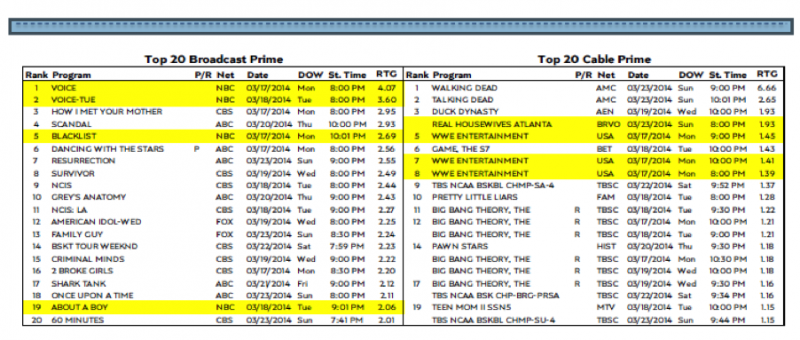Jeff Bader is currently President, Program Planning, Strategy and Research at NBC Entertainment. He is responsible for overseeing long and short term program planning for NBC's primetime, daytime, and late night programming. The NBC Entertainment scheduling department reports to him as well as the division's research team. He also supervises the windowing strategy for primetime and late night programming across all NBCU platforms as well as interfacing with NBC News and NBC Sports. Further, he works closely with the east coast's network division, led by Ted Harbert, to provide coordination with the sales, affiliate, and distribution areas. Bader visited with an Annenberg {M2e} undergraduate communication seminar in March and joined Katelyn Foley for a follow-up dialogue shortly thereafter.
How have audience metrics evolved in the wake of DVRs and SVOD?
When I started more than 27 years ago, we still used Nielsen Pocket Pieces – nothing was electronic. Daily demographic ratings did not exist. It was a very different world. When VCRs became big, you got credit for watching when you recorded. The huge shift happened with DVRs, which gave you credit when you watched as opposed to when you recorded. Now, the business model has changed so that we are actually selling C3 ratings (a combination of audience ratings for average commercial minutes for live broadcasts plus three days of playback on DVRs) as opposed to program ratings. So that was the evolution. Your DVR is actually our “frenemy.” They allow people to skip ads, but people with DVRs, watch so much more TV. The commercial ratings are actually higher in DVR homes rather than non-DVR homes. It’s a bit of a catch-22.
How does your team think about data from social media with significant conversation around TV programming such as Facebook and Twitter?
Social media is an interesting area because we do have people monitoring it and those companies are always out there trying to offer their data services. What we are finding is that social media like Twitter is fairly irrelevant when it comes to how people decide what they are going to watch. The most social program is the ABC Family show Pretty Little Liars. DuringPretty Little Liars, we have a graph that shows the Twitter activity, and it spikes during the show, but the ratings don’t move at all.
Interesting to note that for Pretty Little Liars finale, still only #10 cable show for the week AND 1.2 rating despite huge # of tweets.

We are moving into our pilot season and trying to figure out the best ways to launch shows, but we are now being told that platforms from Facebook to Twitter still are not of primary importance in launching a show. It also doesn’t kill a show and the feature world has shown that repeatedly, but the question is whether it can help while people are watching live. The jury is still out. For the most part, you are talking about tens of thousands of people tweeting and hundreds of thousands of people re-tweeting, which can total a million tweets. But even a low-rated show has a few million people watching, and it’s just not enough to move the needle yet.
Have you faced any organizational challenges integrating new metrics into NBC’s culture?
All networks are starting to use new metrics, so we have all had to be open to changes. ABC, Fox, and The CW have gone to a seven-day delay due to DVR viewing. Nielsen is working on measuring other devices and they are getting there. It’s all an evolution. It’s just that the technology is moving much faster than measuring the devices right now.
Your team also handles scheduling. How do you think about scheduling in this on-demand era, when people are used to having what they want, when they want it?
People are used to turning on the TV and knowing their show is on at 8:00pm. There are people who when they miss something want to go and find it somewhere. But for the most part, the linear broadcast is still the most important broadcast. We are seeing a change. If you look at the live numbers and then you look at the live plus same day, the numbers are big for even people delaying on that same night. And then if you go to three days, they are even bigger. And if you go to seven days, they are obviously even bigger. But 90% of all viewing is done within three days of the original broadcast.

How has windowing changed for television and how do you factor in NBC digital properties such as the NBC website and Hulu vs. non-NBC digital properties such as Netflix?
It has been a lot of trial and error. The main goal is we don’t want to become the music industry. If you don’t have the programming available in some form, will people just pirate it? The whole goal of windowing is to monetize so you can keep paying to produce these programs. If you missed The Blacklist, you can go to iTunes and buy the episode. You can watch it on NBC.com starting the next day. You can watch it on VOD starting the next day. Usually we have five trailings, so five episodes will go up at a time. Then, six weeks in, the first one disappears. So you can still go and get it on iTunes, but people expect to get things for free.
So the question is can we create an ecosystem where shows are available for free? This actually means you are paying for something in order to get it for free. This is the TV Everywhere model. You are an authenticated Comcast customer, giving you access. If you don’t have a TV but have a computer, you can watch shows at a dot-com instead.
How do you decide where to place TV shows, particularly online?

You have built your career around traditional network television, but are now heading a group that is deeply impacted by digital media. How have you kept your roles flexible and open to major changes in the industry?
As the head of scheduling for a network or the department that schedules the network, I used to oversee just scheduling of linear television. It was a chess game before and now it a multi-dimensional chess game. It’s structured a little different at ABC. At ABC, I had someone working for me that was in charge of multi-platform scheduling. Here, there are a lot of people involved in it. It’s not linear anymore—it’s multi-platform. At a high level, my focus is how we get more revenue out of our programs.
What are some key roles that you would like to fill on your teams in the coming months?
It’s really trying to stay as current as we can in what is happening in the multi-platform world and making sure my team can stay on top of that. That’s our main goal.
Are your teams broken down by different areas, such as linear TV, social media, etc.?
We can’t have it that specific because 97 or 98% of the revenue comes from the linear broadcast. My research group is about the quality of the shows. It doesn’t matter where the show airs—the quality has to be the quality. Are they doing different things in the way they are testing the shows? Absolutely. We have gone from doing testing on cable systems to testing on computers. They are changing in that way. Theoretically, their job shouldn’t change no matter where people are watching. Maximizing the quality of the show is the main goal.
And finally, I saw that NBC recently announced that it will be creating digital content to promote TV + digital ad sales. How does the company think about expanding traditional shows into digital experiences that can be consumed with live TV?
It is something that everyone has been trying for years and years. The digital extensions have been around for a long time. Some of them have been pretty successful from a viewer perspective, but people don’t know that most of them exist. For the ones that we are proposing now, we are trying to bring advertisers in. It lets them own a little piece of a show instead of sharing the show with ten other advertisers.
It’s a different world now because those shorts can show up in different places. There are interesting ideas out there and it’s always been how do you pay for them? So by bringing in the advertisers early it helps answer that question. This is just an evolution. These digital shorts have only been around for six or seven years now. For ABC, we did them for Lost. Again, we are just trying to stay current with what’s actually out there in the digital world.
(Source: http://adage.com/article/media/nbc-universal-creates-digital-video-initi...)









